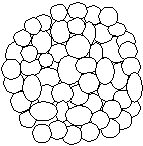Are Asteroids Rubble Piles?
As ground imaging techniques improve and as more spacecraft make close encounters with asteroids we are increasingly observing that an asteroid may not be a single body. Several asteroids have now been discovered that have two or more components gravitationally bound to each other. Many researchers now consider that even when an asteroid looks to be a single body, it may in fact be composed of many smaller rocks loosely held together by their mutual gravitational force.
|
This has led to development of the "rubble pile" model for an asteroid. The main fact that seems to suggest that many asteroids may in fact fit this model is the observation that no asteroid more than 200 metres in diameter has a rotational period less than about 2.3 hours. In fact there seems to be a sharp cutoff at around this value. A rubble pile could not have a rotation faster than this value without flying to pieces.
|

|
We can derive a simple formula to show this by considering a spherical rubble pile of rocks with a radius r, a total mass M, and spinning with an angular velocity w. Now imagine that we place another smaller rock of mass m on the "surface" of this rubble pile. To find the maximum angular velocity that the asteroid may have we only need equate the gravitational force which binds the small rock to the pile with the centrifugal force it will experience tending to throw it off the pile. This gives us the equation:
G M m / r2 = m r w2
where G is the universal gravitation constant. We can eliminate both the mass M and the radius r of the asteroid by substituting the expression for the asteroid's density d. This gives us a final result for the minimum rotational period Tmin of:
Tmin = SQR[3 pi / ( d G ) ]
Density
(kg/m3) |
Min Period
(hours) |
Rotation
(revs/day) |
The table at left shows the values produced from this equation for different asteroidal densities. Note that 1000 is the density of water, and 7700 is the density of iron. The average asteroid is assumed to have a density of around 2500, which gives a maximum rotation rate of about 11 revolutions per day (a period of about 2.2 hours).
This model has strong implications for any attempt to deflect such a body from a collision course with the Earth. It will be much more difficult to do so than if the asteroid was an homogeneous body.
|
|
500
1000
1500
2000
2500
3000
3500
4000
4500
5000
6000
7000
8000
|
4.6
3.3
2.7
2.3
2.1
1.9
1.8
1.7
1.6
1.5
1.4
1.3
1.2
|
5.1
7.3
8.90
10.3
11.5
12.6
13.6
14.5
15.4
16.3
17.8
19.2
20.6
|
